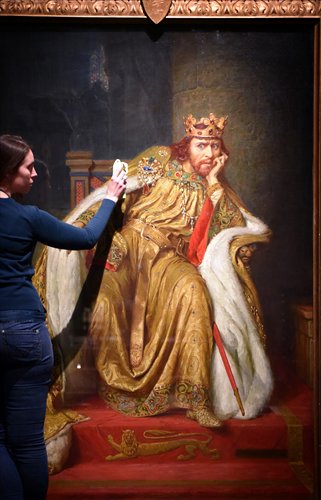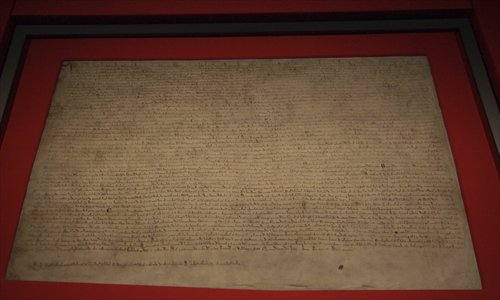800 years of the Magna Carta
The British Library holds landmark exhibit

A British Library staff dusts a painting on loan from the Victoria and Albert Museum to the Magna Carta Law Liberty Legacy. Photo: Courtesy of Clare Kendall
The British Library is holding a landmark exhibit of the Magna Carta starting this month.
Latin for "the Great Charter," the Magna Carta is one of the most famous documents in the world. It established for the first time that everybody was subject to the law, and that nobody - not even the king - was above the law.
2015 marks the 800th anniversary of the Magna Carta.
"We really hope that visitors to our exhibit could examine what the Magna Carta is about and why it remains relevant," Julian Harrison, the exhibit's co-curator, told the Global Times.
"Magna Carta: Law, Liberty, Legacy" showcases over 200 different items, including medieval manuscripts, royal artifacts, books, paintings, artworks and drawings.
Starting with the events that led to King John's meeting with the barons at Runnymede in June 1215, the exhibit examines the history and legacy of the Magna Carta from its medieval origins to its iconic modern status.
Originally a practical solution to a political crisis between King John and his barons, it has proven highly adaptable over the past 800 years.
Three Magna Carta clauses remain valid in today's English law. One protects the independence of the Church of England; another protects the liberty of the city of London and other towns, ports and boroughs. The third is the most important because it gives all "free men" the right to justice and a fair trial, and established that the king was not above the law.
The third clause is symbolic, because lawyers adapt it to current laws and treatise including the European Convention on Human Rights.
Although almost all of its provisions have now been repealed, the Magna Carta remains a cornerstone of the British constitution.
"By coming to our exhibit, people are able to discover the various reuses of the Magna Carter across centuries," Harrison said, adding that public figures such as Winston Churchill, Mahatma Gandhi, and Nelson Mandela used or quoted the Magna Carta on significant occasions.
Historical reunion
"The British Library exhibit is the focus of global celebrations," Harrison said.
The first Magna Carta was drafted by the Archbishop of Canterbury and approved by King John on June 15, 1215. It was reissued and reaffirmed in succeeding years.
Two of the four surviving original Magna Carta manuscripts are on display in the last exhibit room, where the lights are dimmed to avoid damage to the document.
One of the original copies, the "Burnt Magna Carta" damaged in a fire more than 280 years ago was restored last year.
Researchers used a technique called multispectral imaging to decode the text of the burnt parchment, which allows a significant portion of the text to be readable.
In February, the four surviving copies of the original Magna Carta were displayed side-by-side at the British Library for the first time ever.
More than 40,000 people entered a raffle for the chance to see them, with 1,215 chosen to visit the display, according to the Daily Mail report.
Apart from the two original copies of the Magna Carta, the exhibit includes two of the most iconic documents in American history, which were believed to be hugely inspired by the Magna Carta - Thomas Jefferson's handwritten copy of the Declaration of Independence, and the Delaware copy of the US Bill of Rights.
On loan from the New York Public Library and the US National Archives, it's the first time for both documents to come to the UK.
Other iconic documents on display which build on the legacy of the Magna Carta are the Petition of Right (1628), the English Bill of Rights (1689) and the Universal Declaration of Human Rights (1948).
The exhibit also includes two molars and a thumb bone of King John, who granted the charter of the Magna Carta. Borrowed from Worcester Cathedral, they were discovered when King John's tomb was opened in 1797.

One of the remaining Magna Carta manuscripts from 1215 is displayed at the British Library. Photo: IC
Global echoes
The Magna Carta did not gain legal and political significance in the beginning.
Evidence can be found in William Shakespeare's play, King John. One thing that Shakespeare failed to mention in the play is the Magna Carta.
It shows that "even at the end of 16th century, the Magna Carta didn't necessarily have the significance we place on it today," Harrison explained.
However, the Magna Carta has evolved into an international symbol for freedom and the rule of law over time. It has inspired the drafters of modern documents and is considered as the UK's only significant export other than the English language.
Good examples of the Magna Carta's importance and influence are some government papers from the British Cabinet in 1941.
The documents on display showed that the UK government proposed to give one of the original 1215 Magna Carta documents to win US support in World War II.
The papers, on loan to the Library from the National Archives, were annotated by then-British prime minister Winston Churchill and describe the suggested gift as "the only really adequate gesture in our power to make in return for the means to preserve our country."
Co-curator Dr Claire Breay said, "The exhibit challenges visitors to consider what the Magna Carta has meant over time, how it acquired its iconic status and meaning, and why it is still resonates 800 years after it was first granted."
The exhibit runs until September 1, 2015 at the British Library.